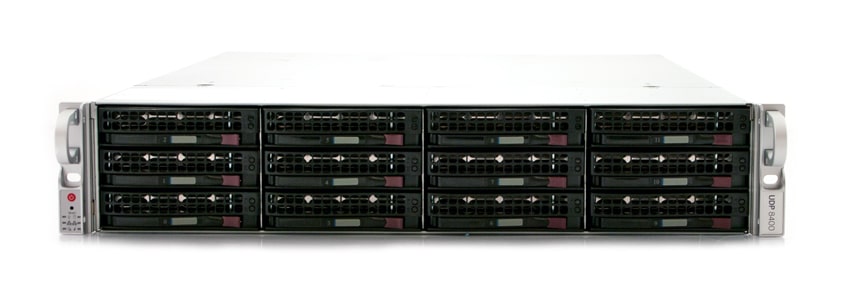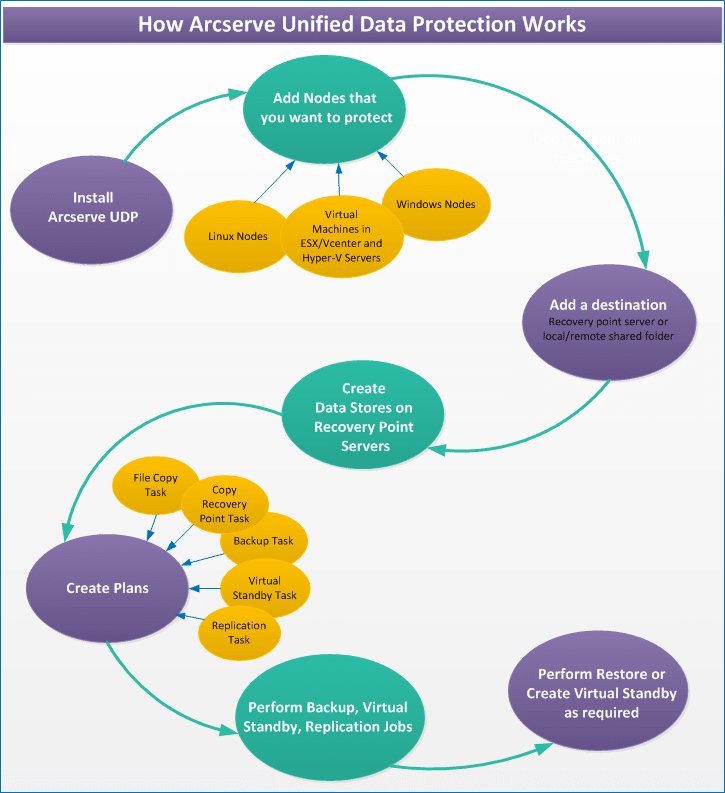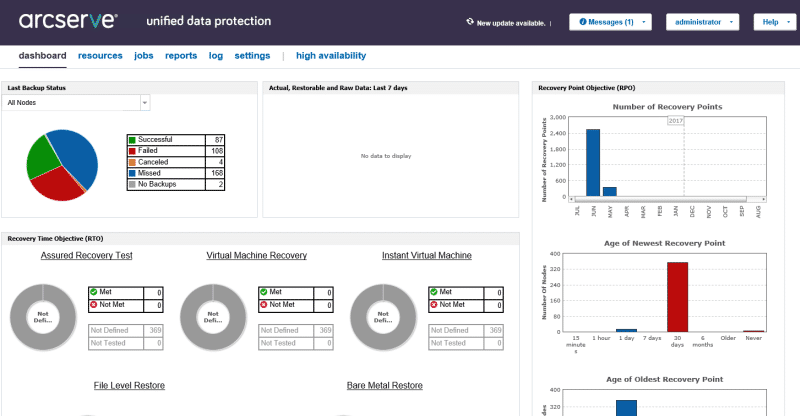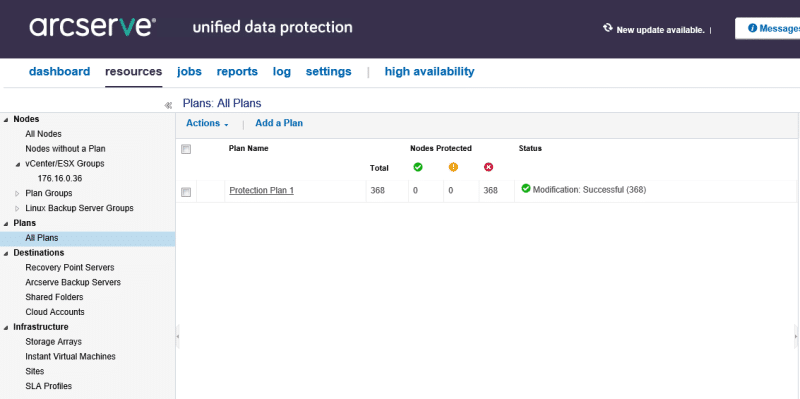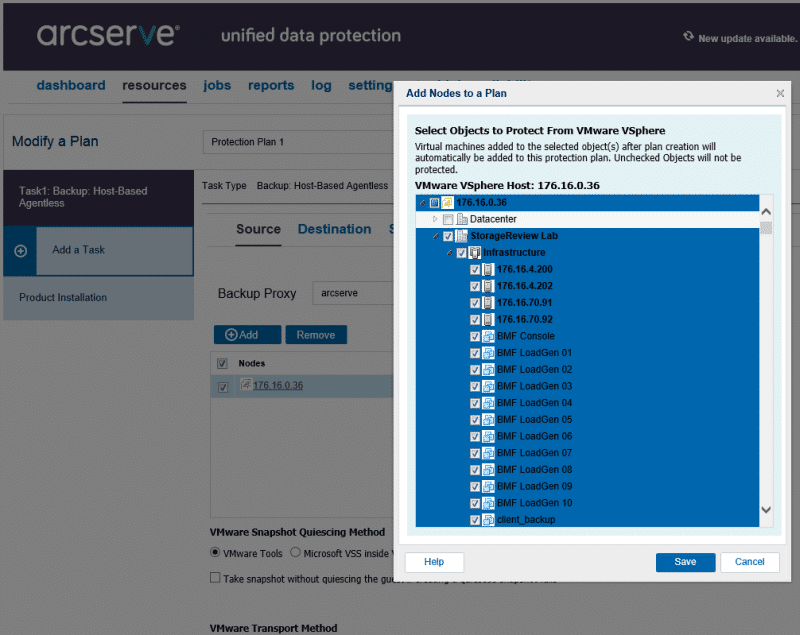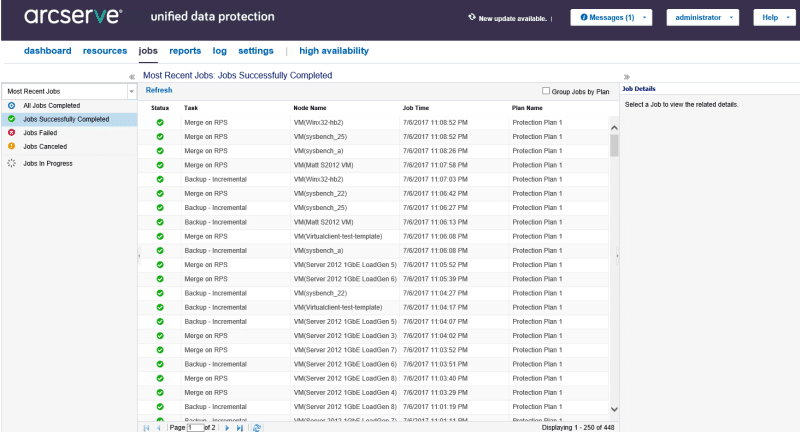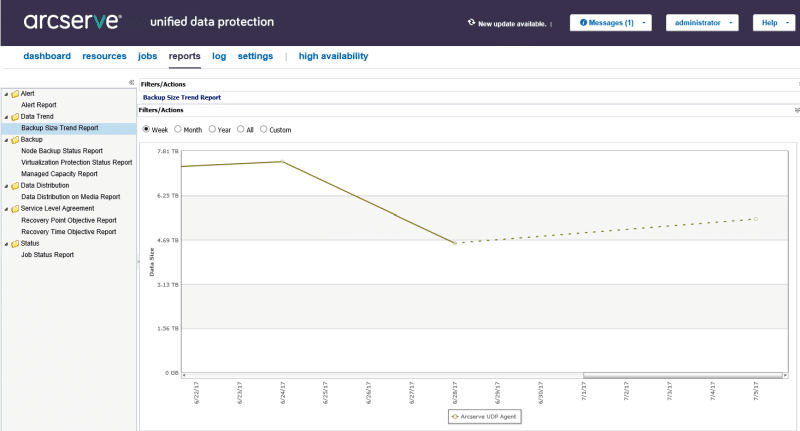
The Arcserve UDP 8400 packages a suite of backup and restore functionality into a 2U rack-mounted appliance aimed at the mid-market. The 8400 promises a comprehensive set of backup features from individual appliances, or as part of a larger deployment with multiple Arcserve 8000 units. Arcserve is promoting the fact that their new generation of appliances has not only brought higher capacities and density, but also features hardware improvements across the board to meet higher expectations in enterprise environments.
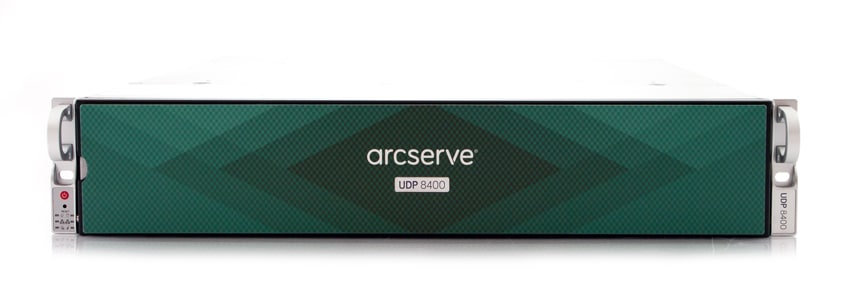
On the hardware end, Arcserve 8000 systems feature Intel E5 V4 Xeon processors with 8 to 12 cores (depending on model), Intel SSD, 12Gbps SAS storage HDDs, DDR4-2400Mhz RAM, and 12Gbps RAID cards with Cache and Battery Backup. The lineup incorporates redundant hot-swap power supplies. Some 8000 series appliances incorporate dedicated SAS HBAs.
- 8100 series base configuration: 1U, 4TB storage, 32GB of RAM.
- 8200 series base configuration: 1U, 8TB storage, 32GB of RAM.
- 8300 series base configuration: 2U, 16TB storage, 64GB of RAM.
- 8400 series base configuration: 2U, 32TB,storage, 128GB of RAM.
Our review unit is an Arcserve UDP 8400, currently the highest-performing tier in the Arcserve 8000 lineup, with the 1.2TB SSD option. The SSD plays an important role in system performance, as it’s leveraged to help perform the inline deduplication tasks, helping to eliminate a potential bottleneck if that job were left to the HDDs. The net benefit is this allows Arcserve to write optimized data to the datastore, increasing the amount of source data that can be consumed and protected on a given appliance.
Our 8400 features the base 1GbE networking option. The array of performance benchmarks we use for storage arrays would be bottlenecked by this network connection, so while NIC performance while ingesting data is a factor to consider in a backup and recovery appliance like this, it is not necessarily a primary factor. Our review will focus on UDP 8400’s functionality and out-of-box experience to find out if it lives up to the premise of an appliance that is straightforward to bring online and manage in a mid-market environment.
Arcserve UDP 8400 Appliance Specifications
- System RAM: 128GB
- Max RAM: 160GB / 192GB / 256GB (sizing based on customer Virtual Standby / Instant VM needs)
- SSD Drive: 1.2TB
- Processor: E5-2650 V4, 12-core, 2.2GHz
- RAID Card: 9361-8i
- RAID Configuration: RAID-6 with BBU
- Drive Bays: 12
- Drives:
- 6x 8TB SAS 12G (32TB Raw)
- 7x 8TB SAS 12G (40TB Raw)
- 8x 8TB SAS 12G (48TB Raw)
- 9x 8TB SAS 12G (56TB Raw)
- 10x 8TB SAS 12G (64TB Raw)
- 11x 8TB SAS 12G (72TB Raw)
- 12x 8TB SAS 12G (80TB Raw)
- DIMMs / Max DIMMs: 4x 32GB DDR4-2400 / 8
- Base PCIe Cards: RAID 1G cache 8-port, LSI SAS 9300-8e, Quad-Port 1G NIC
- PCIe Cards (factory option):
- Dual-Port 10G Copper
- Dual-Port 10G SFP+
- Dual-Port FC 16G HBA
- Power Supplies: 2x Hot-Swap Redundant 920W AC Platinum
- Weight: 46lbs / 21kgs
- Dimensions (WxHxD): 3.5″ x 17.2″ x 25.5″ / 8.9cm x 43.7cm x 64.8cm
- Warranty: 3-year hardware
Build and Design
The Arcserve UDP 8400 is a 2U system, and it ships with a pair of 2-post quick-rail assemblies as well as the mounting hardware for 4-post racks. The front panel incorporates a straightforward control and monitoring area at bottom left. There are buttons for power on and power reset, along with LED activity indicators for power, drive activity, and network activity, and indicators for power failures and other system information alerts.
The rear panel of the Arcserve UDP 8400 provides access to the system’s dual power supply bays, and on the left, two optional SSD bays. Farther to the right lie an IPMI management port, a COM port, 4 USB ports, dual Ethernet ports, and a VGA port. The rear panel uses low-profile PCIe expansion slots for external SAS 9200 8e HBA ports and a quad-port NIC card, as well as offering one open slot. At the far right, the UDP 8400 uses one of its full-height PCIe slots for an LSI 9361-8i RAID controller card, leaving three full-height slots for expansion.
Management
As a backup appliance, the UDP 8400 is meant to be dropped into existing environments, and particularly into environments which may lack dedicated staff and hardware to manage backup and recovery. In our experience over the last few months, the appliance was very easy to get operational and required minimal administration once online. If anything, we did our best to trouble it, routinely taking it on and offline as the lab environment we had it backing up was always in flux. Aside from needing to renew a license due to the duration of our testing, we had no other complications at all.
Arcserve UDP platform overview:
- Protect source nodes
- Backup and replicate to recovery point servers and secondary backup locations
- Create virtual standby machines from backup data
- Restore backup data and perform Bare Metal Recovery (BMR)
- Restore Microsoft Exchange email and non-email objects
- Monitor High Availability
After first boot, the Arcserve UDP Appliance Wizard appears in order to facilitate basic system configuration. The wizard configures the appliance’s host name, network settings, email and alerts, and the initial data protection plan. Protection plans describe the relationships between source nodes and backup storage, along with the schedule for backups. Once this initial configuration has been completed, the 8400 launches an Arcserve UDP dashboard. Arcserve UPD offers a source-side and global deduplication solution with support for source nodes running Windows and Linux, along with support for VMs running on VMware ESX servers or Microsoft Hyper-V.
Arcserve UDP conceptualizes its configuration in terms of Plans, to which nodes can be added and configured. The 8400 can be configured for High Availability and can be set to create Virtual Standby machines from source nodes. Arcserve UDP offers replication of backup data to recovery point servers, including remote Recovery Point Servers. A UDP Recovery Point Server is a centralized backup server, which aggregates backups from multiple points, including global deduplication.
Nodes can be added to a Plan by IP Address or hostname, Active Directory, vCenter/ESX Nodes, and Microsoft Hyper-V servers.
UDP allows administrators to set the backup destination to a local machine or a recovery point server. Arcserve UDP can also archive data to tape storage. In the event of data loss, Arcserve UDP provides several workflows to restore backup data and manage bare metal recovery.
Arcserve UDP features an assortment of built-in report types. In addition to the self-descriptive Alert Reports, Managed Capacity Reports, Node Status Reports, and Data Distribution on Media Reports, UDP has several reports that dovetail with its backup and restore functionality. The Backup Size Trend Report plots backup size in a historical view and projection of its growth trend with detailed information on individual nodes. A Virtualization Protection Status Report displays the backup status for individual VMS protected by host-based backup, Virtual Standby, or Arcserve Backup.
Conclusion
The UDP 8400 is a deliberate move on Arcserve’s part to move farther towards the enterprise end of the mid-market that has been the focus of their UDP appliances in the past. With only the baseline 4x1GbE network interfaces on our review unit, this has been a chance to focus on the experience of setting up and working with the UDP 8400 in the kind of mid-market environment where it has been designed to excel. In reality, 4x1GbE is often adequate bandwidth to serve the backup and recovery needs of the mid-market.
On those terms, the Arcserve has delivered on the premise of making it simple to deploy an on-site, scalable backup and recovery appliance. The UDP administrative interface and workflows were convenient, yet robust. The UDP documentation itself is both concise and comprehensive, which is not always true even of much more expensive enterprise storage arrays.
For many manufacturers, the concept of an appliance is not synonymous with options for upgrading the hardware. Arcserve’s UDP 8000 series is a welcome exception, however. The hardware platform offers many opportunities for customization at the factory and after deployment. In addition to increased storage, the 8000 series generally offers RAM expansion in order to accommodate additional Virtual Standby and Instant VM use, and a wealth of PCIe slots.
Pros
- Streamlined set up and administration
- Robust deduplication, backup, and recovery functionality
- Ample PCIe and RAM expansion options
- Equipped with external SAS connections for expansion
Cons
- Interface did feel sluggish at times if backup was operating in background
The Bottom Line
The Arcserve UDP 8400 is straightforward to configure, requires minimal ongoing management, and offers a range of useful mid-market backup and recovery functions.
Sign up for the StorageReview newsletter

